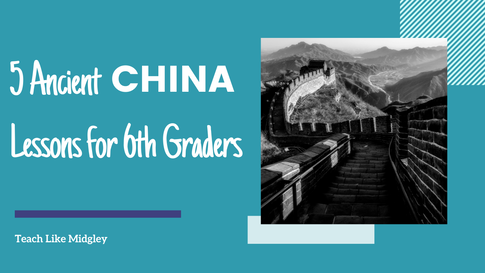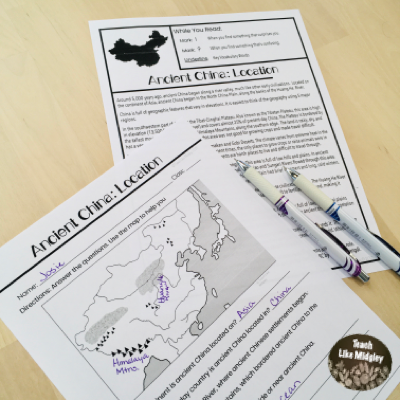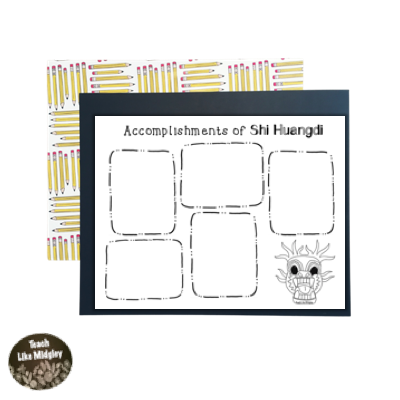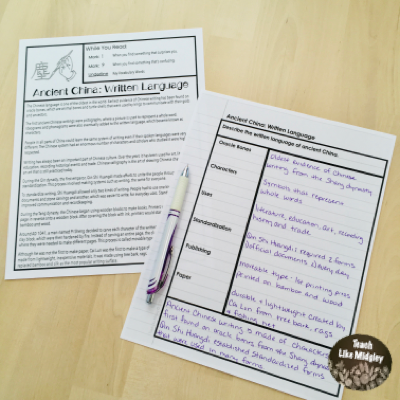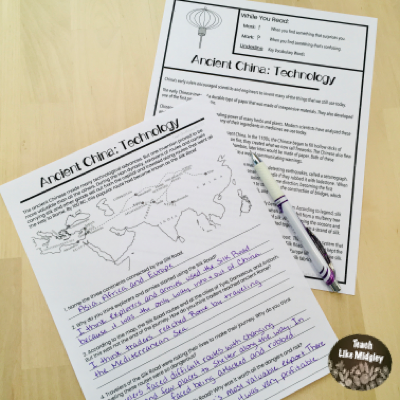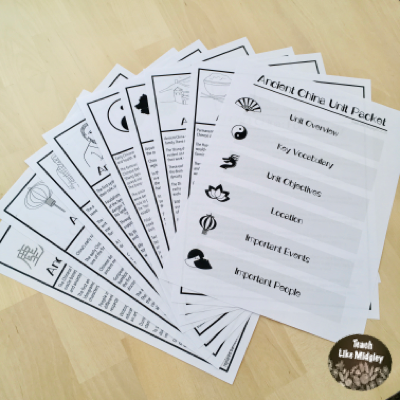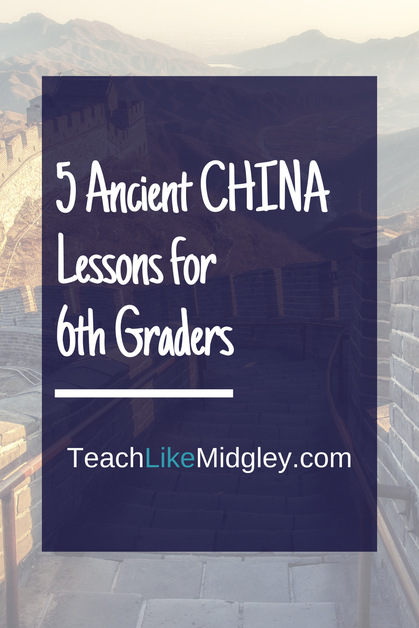5 Ancient China Lessons for 6th Graders
When you sit down to write your lesson plans for ancient China, it can be hard to know where to start.
It can be easy to get caught up in the fun of student projects. And while research projects can be beneficial, we also want to make sure students are learning key concepts.
It can be easy to get caught up in the fun of student projects. And while research projects can be beneficial, we also want to make sure students are learning key concepts.
Even though ancient China may not be viewed as popular or exciting as Egypt, Greece, or Rome, there is plenty to learn and excite students. And just like every other ancient civilization, ancient China has its own unique characteristics and concepts to study.
In this post, you’ll learn about 5 key concepts you should be including in your ancient China lesson plans.
Unique Geography
For many years the ancient Chinese we isolated from the rest of the world. Their location provided many natural geographic barriers that kept people from traveling in and out.
The deserts, mountains, and plateau provided a great deal of protection for the people who settled in the North China Plain.
Using elevation maps and color coding the different layers of ancient China can help students understand the isolation that existed for many, many years.
It wasn’t until the Han Dynasty, that ancient China really had any interaction with the outside world.
The deserts, mountains, and plateau provided a great deal of protection for the people who settled in the North China Plain.
Using elevation maps and color coding the different layers of ancient China can help students understand the isolation that existed for many, many years.
It wasn’t until the Han Dynasty, that ancient China really had any interaction with the outside world.
Qin Shi Huangdi
No study of ancient China is complete without Qin Shi Huangdi. He was the first ruler to unite all of ancient China under one rule, making him the first emperor.
Although he was the only ruler of his dynasty and disliked by many, he accomplished many things for ancient China.
Qin Shi Huangdi developed a bureaucracy and ordered the first Great Wall to be built. He also standardized many aspects of daily life that helped unite the people together.
Not to mention the elaborate tomb he had built and filled with life-sized teracotta clay soldiers.
Although he was the only ruler of his dynasty and disliked by many, he accomplished many things for ancient China.
Qin Shi Huangdi developed a bureaucracy and ordered the first Great Wall to be built. He also standardized many aspects of daily life that helped unite the people together.
Not to mention the elaborate tomb he had built and filled with life-sized teracotta clay soldiers.
Standardization of Written Language
Along with Qin Shi Huangdi’s standardized systems, was written language. Ancient Chinese characters are considered to be a form of art.
Qin established two forms of the written language to be used. One for formal documentation. The other a simple, quicker version to be used for ordinary every day writing tasks.
Not only did this make writing a less complicated task, it also helped in uniting the people by having a standard that everyone used which also made communication easier.
Qin established two forms of the written language to be used. One for formal documentation. The other a simple, quicker version to be used for ordinary every day writing tasks.
Not only did this make writing a less complicated task, it also helped in uniting the people by having a standard that everyone used which also made communication easier.
Ancient China Inventions
Ancient Chinese scientists developed many important inventions and made discoveries in a variety of areas.
In publishing, they created paper of lightweight and inexpensive materials. They also invented moveable type, which is a block system used like a printing press.
Gunpowder is another Chinese invention. Although it was actually discovered by accident when mixing substances looking for new cures. By lighting sticks of bamboo filled with gunpowder, they created what we now call fireworks.
There were several other significant inventions like the compass, a seismograph, and even kites that were used for signaling.
Another invention was silk, a fabric made from threads taken from the cocoons of caterpillars. Silk became very important to ancient Chinese trade, since they were the only people to hold the secret to how it was made for many years.
In publishing, they created paper of lightweight and inexpensive materials. They also invented moveable type, which is a block system used like a printing press.
Gunpowder is another Chinese invention. Although it was actually discovered by accident when mixing substances looking for new cures. By lighting sticks of bamboo filled with gunpowder, they created what we now call fireworks.
There were several other significant inventions like the compass, a seismograph, and even kites that were used for signaling.
Another invention was silk, a fabric made from threads taken from the cocoons of caterpillars. Silk became very important to ancient Chinese trade, since they were the only people to hold the secret to how it was made for many years.
The Silk Road
There was a great demand for China’s silk fabrics. So it is no wonder that the only trade route in and out of China was named after the valuable export.
The Silk Road was actually made up of many roads and connected China to western Asia.
Merchants traveled the dangerous road to trade their goods and also to learn about other cultures and ideas.
The Silk Road was actually made up of many roads and connected China to western Asia.
Merchants traveled the dangerous road to trade their goods and also to learn about other cultures and ideas.
Ready to Roll Materials...
Now that you know about some of the key concepts to include in your lesson plans, you are ready to get started.
However, if you are looking for a bit more guidance or are limited on resources from your district, then you may be interested in these done-for-you resources to help you teach ancient China.
In my TpT store, you’ll find everything from planning checklists, to done-for-you lesson sets, map study, timelines, leveled projects, to review games and even a unit test.
Teachers shouldn’t have to go it alone and spend their precious time scouring for resources to help them teach. That’s why Teach Like Midgley is here, to help provide quality resources to help you do what you do best, TEACH.
However, if you are looking for a bit more guidance or are limited on resources from your district, then you may be interested in these done-for-you resources to help you teach ancient China.
In my TpT store, you’ll find everything from planning checklists, to done-for-you lesson sets, map study, timelines, leveled projects, to review games and even a unit test.
Teachers shouldn’t have to go it alone and spend their precious time scouring for resources to help them teach. That’s why Teach Like Midgley is here, to help provide quality resources to help you do what you do best, TEACH.
You May Also Like...
Let's Connect...

Welcome! I'm Hillary Midgley, a veteran 6th grade teacher.
I create educational materials and develop curriculum for other teachers. I specialize in teaching students how to learn through my Study Skills Curriculum. I have established fundamental classroom systems and structures for teachers to help them streamline their classroom. And my passion is teaching ancient history through engaging activities with foundations in academic skills. Here you will find resources on all of these topics and more. Learn more about me here.
|

